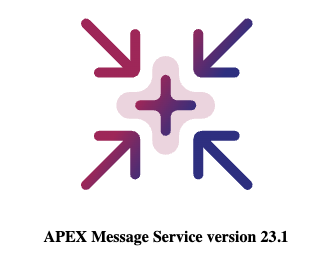Configuration
APEX Message Service can be configured through the ams_config.jsonc file or through parameters when AMS is being started.
Server Options
To view all available options, run ./APEXOfficePrintLinux64 -h
The following parameters can be used:
-a or --activate : Activate the software
-r or --reactivate : This reactivates the software.
--generate_lrf : Generate license request file
-h or --help : Show this menu
--license : The location of the license file.
Default looks at the startup directory
--deactivate : This creates a deactivation request file.
AMS can also use a config file. These options can be saved in this config file. AMS generates the config file in the first run if no config file exists. This configuration file is in JSON format. The default configuration is as follows:
{
// Client and Server listen events: these are the events that are used to communicate between the client and the AMS server (you also need to change this on APEX)
"events": {
"clientListenEvent": "uc.event",
"serverListenEvent": "uc.event"
},
// Socket.io options see https://socket.io/docs/v4/server-options/ for more info
// Not supported are: adapter, parser, allowRequest, wsEngine
"io": {
"cors": {
"origin": "*",
"allowedHeaders": "*",
"credentials": false
},
// Webtransport is not yet supported
"transports": [
"websocket",
"polling"
]
},
// Logging options
"logging": {
// The level of logging, possible values are: error, warn, info
"level": "info",
// The directory where the logs are stored
"dir": "logs",
// Set this to true if you want to log to the console as well as to file
"consoleLogs": true
},
// The port on which the server should run
"port": 3000,
// The amount of workers the server starts. If 0, it will use all of the cores available
"numberOfWorkers": 1,
// Path and filename of the signed certificate. Both 'httpsCert' and 'httpsKey' have to be provided in order for HTTPS to work
"httpsCert": "",
// Path and filename of the private key
"httpsKey": "",
// Interval for license data to be written. This number controls the interval which checks whether the limit needs to be reset. Defaults to 1 second, but the number can be increased to minimize disk I/O
"licenseCheck": 1000,
}
Testing the connection to AMS
Running curl webserver:port (curl can be downloaded for free for Windows via https://curl.haxx.se/download.html#Win64)
curl 127.0.0.1:3000
If you access the port running AMS, it should return a webpage

Rate limit information
To view rate limit information, visit the /ratelimitinfo API endpoint of the AMS server.
{
// Messages sent since last reset
"counter": number,
// Rate limit time frame (in milliseconds)
"duration": number,
// Rate limit remaining time frame (in milliseconds)
"timeLeft": number,
// The amount of messages, depending on your license
"limit": number
}
Reverse Proxy
Since this is a product based on WebSockets, when you use a reverse proxy, you need to make sure that the reverse proxy supports WebSockets. And also configure it correctly. For more information on how to setup we refer to the following documentation: Reverse Proxy
Security Best Practices
These security best practices apply not only to AMS but also to any other software application.
- Create a new user specifically to run the AMS SERVER, e.g. ams
Give only the required privileges: access to incoming requests on the given port.
-
Setup the firewall so that only the database server can connect to the AMS Server port OR use the IP whitelist feature of AMS only to allow access from the IP of the database server
-
Configure HTTPS either using a reverse proxy or behind a load balancer that supports HTTPS.